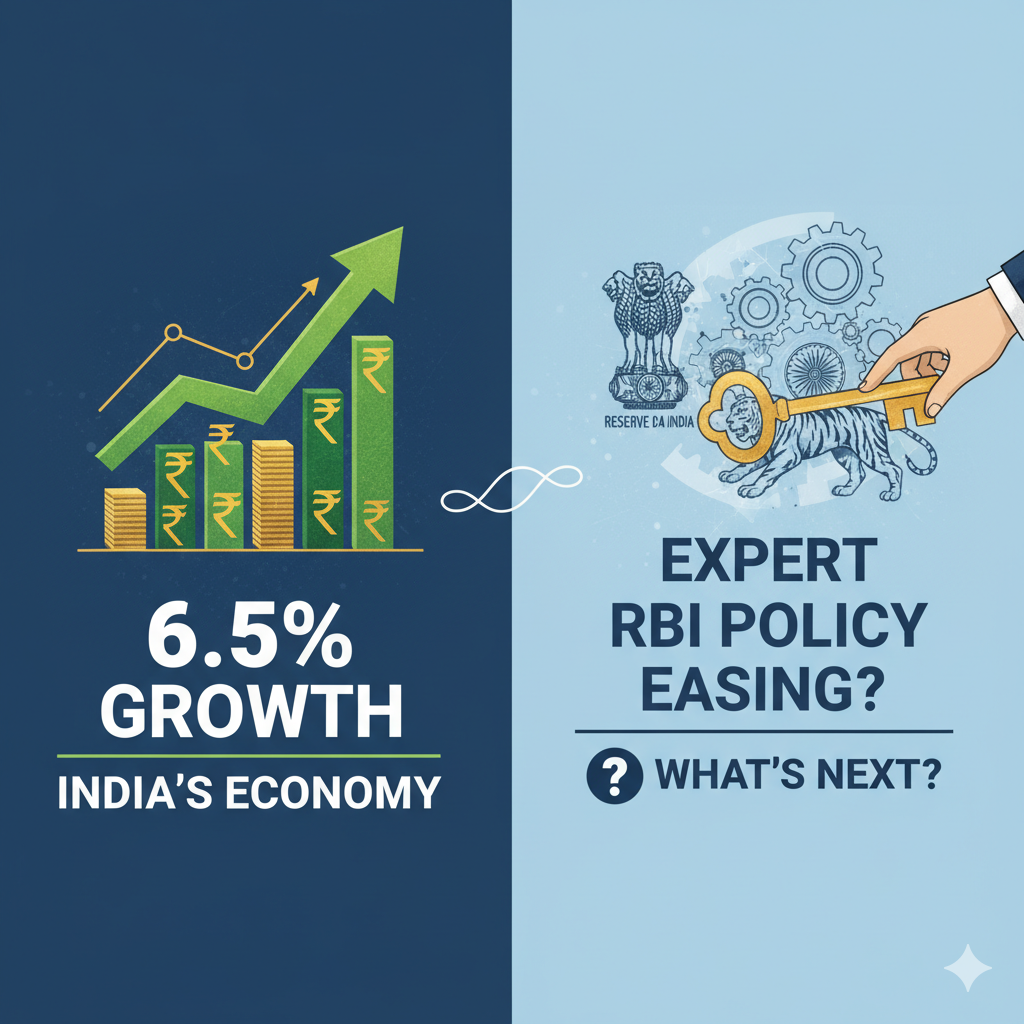Does India’s 6.5% Growth Signal Expert RBI Policy Easing?
RBI monetary policy easing India prospects have strengthened significantly. Furthermore, recent statements from Deputy Governor Poonam Gupta confirm this trend. Additionally, India economic growth outlook 2025 remains robust at 6.5%. Moreover, policy rate cuts India prospects are gaining momentum. Learn more about financial planning strategies.
Table of Contents
- What Makes RBI Monetary Policy Easing India Viable Now?
- How Does India Economic Growth Outlook 2025 Support Rate Cuts?
- Why Are Policy Rate Cuts India Prospects Strengthening?
- What Expert Insights Drive RBI Policy Decisions?
What Makes RBI Monetary Policy Easing India Viable Now?
India’s economic fundamentals have strengthened considerably this year. Consequently, the Reserve Bank maintains confidence in growth sustainability. Furthermore, inflation trends support accommodative monetary policy measures. Additionally, fiscal policy coordination enhances overall economic stability.
Subsequently, monetary policy can focus on cyclical growth support. Therefore, RBI monetary policy easing India becomes increasingly feasible.
“India is growing steadily at 6.5 per cent, with a forecast of 6.8 per cent. However, this is not India’s destination yet, and there remains room for policy easing.”
Key Economic Indicators Supporting Policy Easing
- GDP growth maintains steady 6.5% trajectory consistently
- Inflation remains within RBI’s comfortable target range
- Fiscal policy demonstrates improved transparency and efficiency
- Structural reforms continue supporting sustainable economic expansion
How Does India Economic Growth Outlook 2025 Support Rate Cuts?
The India economic growth outlook 2025 presents compelling arguments. Specifically, robust GDP performance creates policy space effectively. Moreover, high-frequency indicators confirm sustained economic momentum. Additionally, manufacturing and services sectors show balanced growth patterns.
Economic resilience has impressed international observers significantly. Furthermore, IMF meetings highlighted India’s exceptional performance globally. Subsequently, global growth forecasts have been upgraded accordingly. Therefore, domestic policy flexibility has increased substantially.
| Economic Indicator | Current Status | Policy Impact |
|---|---|---|
| GDP Growth Rate | 6.5% (Q1 FY26: 7.8%) | Supports easing |
| Inflation Trajectory | Within target range | Allows flexibility |
| Fiscal Position | Improved transparency | Enables coordination |
| Global Outlook | Upgraded forecasts | Reduces constraints |
Manufacturing Sector Challenges and Opportunities
Manufacturing growth faces global trade headwinds currently. However, domestic demand remains resilient and supportive. Moreover, productivity improvements continue driving sector competitiveness. Additionally, government initiatives support manufacturing sector expansion.
Why Are Policy Rate Cuts India Prospects Strengthening?
Policy rate cuts India prospects have improved markedly. Specifically, inflation components show divergent but manageable trends. Furthermore, food price deflation provides temporary relief significantly. Additionally, core inflation remains range-bound throughout this year.
Monetary policy transmission mechanisms function effectively across sectors. Moreover, banking system liquidity supports credit growth adequately. Subsequently, rate cuts would enhance economic momentum further. Therefore, timing considerations become increasingly important for policymakers.
“The current deceleration in inflation is mostly, if not fully, driven by food prices, which is in deflationary territory and will likely auto-correct.”
Inflation Dynamics Supporting Rate Cut Prospects
- Food price inflation shows deflationary trends temporarily
- Core inflation excluding precious metals remains stable
- Precious metals prices influence overall inflation moderately
- Medium-term inflation trajectory supports policy flexibility
What Expert Insights Drive RBI Policy Decisions?
Expert analysis emphasizes multiple factors influencing policy decisions. Specifically, fiscal and monetary policy coordination remains crucial. Furthermore, structural reforms continue supporting sustainable growth patterns. Additionally, global economic conditions affect domestic policy choices.
Business Standard’s BFSI Summit 2025 provided valuable insights. Moreover, industry leaders discussed banking sector evolution extensively. Subsequently, policy frameworks adapt to changing economic dynamics. Therefore, RBI monetary policy easing India reflects comprehensive analysis.
Global Context Influencing Domestic Policy
International monetary policy trends affect domestic decisions significantly. However, India’s policy independence remains strong and effective. Moreover, emerging market resilience supports flexible policy approaches. Additionally, trade relationship changes create new policy considerations.
Frequently Asked Questions
• What drives RBI monetary policy easing India decisions?
Economic growth sustainability and inflation control primarily.
Furthermore, fiscal policy coordination supports monetary decisions.
Additionally, global economic conditions influence policy timing.
Moreover, structural reforms create long-term policy space.
• How does India economic growth outlook 2025 affect rates?
Strong growth performance enables accommodative policy measures.
Specifically, 6.5% growth provides substantial policy flexibility.
Moreover, upgraded forecasts support easing considerations.
Additionally, balanced sectoral growth reduces policy constraints.
• When might policy rate cuts India prospects materialize?
Timing depends on inflation trajectory and growth momentum.
Furthermore, global economic conditions influence decision timing.
Additionally, fiscal policy coordination affects implementation schedules.
Moreover, banking system readiness determines transmission effectiveness.
• What economic indicators support RBI policy easing?
GDP growth, inflation trends, and fiscal performance primarily.
Specifically, manufacturing resilience and services sector strength.
Moreover, high-frequency indicators confirm sustained economic momentum.
Additionally, global growth upgrades support domestic flexibility.
• How do global factors influence India’s monetary policy?
International trade dynamics and capital flow patterns significantly.
Furthermore, emerging market resilience supports policy independence.
Additionally, global inflation trends affect domestic considerations.
Moreover, geopolitical developments influence policy timing decisions.
External References and Sources
- Business Standard: RBI Deputy Governor Statement
- Reserve Bank of India Official Press Releases
- International Monetary Fund World Economic Outlook
Conclusion
India’s economic fundamentals support monetary policy flexibility significantly. Moreover, RBI monetary policy easing India prospects strengthen with growth. Furthermore, expert insights confirm policy space availability. Additionally, coordinated fiscal and monetary approaches enhance effectiveness.
The India economic growth outlook 2025 remains robust. Subsequently, policy rate cuts India prospects gain credibility. Therefore, investors should monitor policy developments closely. Moreover, economic indicators will guide future decisions.
Disclaimer: This article provides educational information only. Furthermore, it does not constitute financial or investment advice. Additionally, readers should consult qualified professionals before decisions. Moreover, market conditions can change rapidly and unpredictably.
